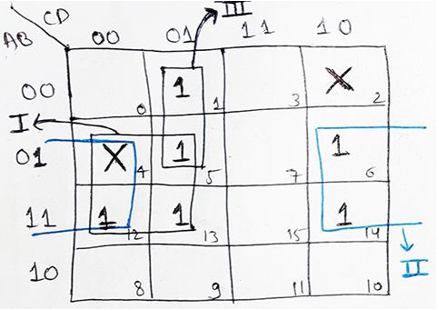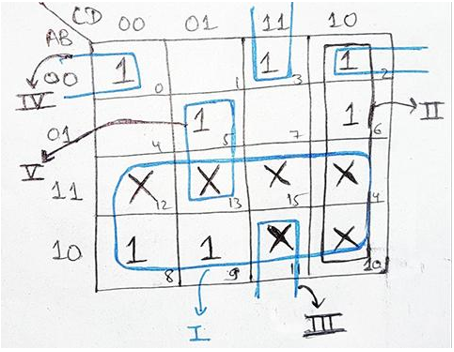卡诺模板
Till now, the Boolean expressions which have been discussed by us were completely specified, i.e., for each combination of input variable we have specified a minterm by representing them as 1 in the K-Map. But, there may arise a case when for a given combination of input we may not have a specified output or the input combination may be invalid. The combinations for which we don't have any output expression specified are called don't care combination.
到现在为止,已经完全指定了我们已经讨论过的布尔表达式,即,对于输入变量的每种组合,我们通过在K-Map中将它们表示为1来指定一个最小项。 但是,可能会出现以下情况:对于给定的输入组合,我们可能没有指定的输出,或者输入组合可能无效。 没有为其指定任何输出表达式的组合称为“ 无关组合” 。
For Example, in 8421 code, input states 1001, 1010, 1011, 1100, 1101, 1110 and 1111 are invalid and the corresponding output is the don't care. Similarly, in Excess-3 code, binary input states 0000, 0001, 0010, 1101, 1110 and 1111 are unspecified and are also represented by don't care.
例如,在8421代码中,输入状态1001、1010、1011、1100、1101、1110和1111无效,而相应的输出则无关紧要 。 类似地,在Excess-3代码中,未指定二进制输入状态0000、0001、0010、1101、1110和1111,也由“ 无关”表示。
These don't care combinations in the K-Map are denoted by an X (cross) symbol.
K映射中的这些无关组合用X(叉)符号表示 。
The X is called "Don't care conditions".
X称为“无关条件” 。
General rules to be followed while minimizing the expressions using K-Map which include don't care conditions are as follows,
使用K-Map最小化表达式时应遵循的一般规则如下,其中包括无关紧要的条件 ,
After forming the K-Map, fill 1's at the specified positions corresponding to the given minterms. Fill X at the positions where don't care combinations are present.
形成K-Map后,在与给定的最小项相对应的指定位置填充1。 在不需要组合的位置填充X。
Now, Encircle the groups in the K-Map. One thing to be kept in mind is, now we can treat Don't Care conditions (X) as 1s if these help in forming the largest groups. No such group can be encircled whose all the elements are X.
现在,在“ K-Map”中将组圈起来。 要记住的一件事是,如果这些条件有助于形成最大的群体,那么我们可以将“无关条件”(X)视为1 。 不能包围所有元素都是X的此类组。
If still there are 1s left which doesn't get encircled in any of the groups, then these isolated 1s are encircled individually.
如果仍然有1个没有被任何组包围的1 ,则这些孤立的1将被单独包围。
Now, recheck all the encircled groups, and remove any redundancy if present.
现在,重新检查所有包围的组,并删除所有冗余(如果存在)。
Write the Boolean expression for each encircled group.
为每个包围的组编写布尔表达式。
The final minimal expression can be obtained by ORing each Boolean expressions that were obtained from each group.
可以通过对从每个组获得的每个布尔表达式进行“或”运算来获得最终的最小表达式。
Point to remember:
要记住的一点:
While designing K-Map using SOP form, don't care conditions (X) are considered as 1, if it helps form the largest group, otherwise it is considered as 0 and are left during encircling. On the contrary, while designing a K-Map using POS form, don't care conditions (X) are considered as a 0, if it helps form the largest group, otherwise it is considered as 1 and are left during encircling.
在使用SOP格式设计K-Map时,如果条件( X )有助于形成最大的组,则将条件( X )视为1,否则将其视为0并在包围过程中保留。 相反,在使用POS表单设计K-Map时,如果条件( X )有助于形成最大的组,则将条件( X )视为0,否则将其视为1并在包围过程中保留。
Example 1: Minimize the given Boolean Expression by using the four-variable K-Map.
F (A, B, C, D) = Σ m (1, 5, 6, 12, 13, 14) + d (2, 4).
示例1:使用四变量K映射最小化给定的布尔表达式。
F(A,B,C,D)=Σm(1、5、6、12、13、14)+ d(2、4)。
Solution:
解:

We will fill 1s at the appropriate minterm positions and also the don't care positions will be filled with (X). Now, we can encircle these 1s and X using the rules we have discussed earlier. We can observe that we can encircle them into three groups. First Group (encircled by black ink) contains four 1s and the Boolean expression given by it is B.C. Second group is the rolling group (encircled by blue ink) which also contains four 1s gives B.D. Third group is the pair of 1s which gives A.C.D
我们将在适当的最小期限位置填充1s ,并且不在乎位置将以( X )填充。 现在,我们可以使用前面讨论的规则将这些1和X圈起来。 我们可以观察到我们可以将它们分为三类。 第一组(用黑色墨水包围)包含四个1,并且它给出的布尔表达式是B. C。 第二组是所述滚动组(由蓝色墨水环绕),其中还包含四个1S给出B. d。 第三组是一对1 ,它们给出A。 ç.D
Hence, the resultant simplified Boolean Expression will be:
因此,结果简化后的布尔表达式将为:
F (A, B, C, D) = B.C + B.D + A.C.D
Example 2: Minimize the given Boolean Expression by using the four-variable K-Map.
F (A, B, C, D) = Σ m (1, 5, 6, 12, 13, 14) + d (2, 4).
示例2:使用四变量K映射最小化给定的布尔表达式。
F(A,B,C,D)=Σm(1、5、6、12、13、14)+ d(2、4)。
Solution:
解:
Solution:
解:

As we have already discussed in our last example, we will fill 1's at the appropriate minterm positions and X at don't care positions, encircling the groups using the rules we have discussed above results into the formation of five groups as seen in the image. The Boolean Expressions given by the groups are A, C.D, B.C. D, A.B.D and B.C.D respectively.
正如我们在上一个示例中已经讨论的那样,我们将在适当的最小项位置填充1 ,在无关位填充X ,使用上面讨论的规则将组圈起来,如图所示,形成五个组。 由基团给出的布尔表达式为A,C. d,B .C。 D, A B. d和B.Ç.D分别 。
ORing these individual Boolean expressions to get the simplified Boolean Expression as:
对这些单个布尔表达式进行“或”运算得到简化的布尔表达式,如下所示:
F (A, B, C, D) = A + C. D + B.C. D + A.B. D + B. C. D
翻译自: https://www.includehelp.com/basics/karnaugh-maps-with-dont-care-conditions.aspx
卡诺模板

)




)





 replica set+sharding)




函数)
)
